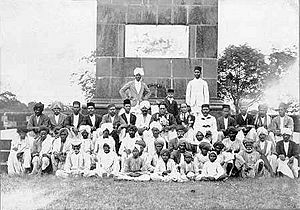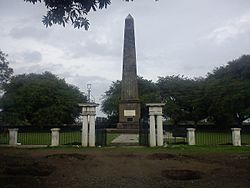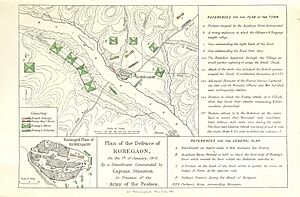Battle of Koregaon facts for kids
Quick facts for kids Battle of Koregaon |
|||||||
|---|---|---|---|---|---|---|---|
| Part of Third Anglo-Maratha War | |||||||
|
Bhima Koregaon Victory Pillar |
|||||||
|
|||||||
| Belligerents | |||||||
| Commanders and leaders | |||||||
|
Captain Francis F. Staunton Shidnaak Mahar Commander of Mahar Regiment |
Peshwa Baji Rao II Bapu Gokhale Appa Desai Trimbakji Dengle |
||||||
| Units involved | |||||||
| 2nd Battalion of the 1st Regiment of Bombay Native Infantry Madras Artillery |
Arabs, Gosains and Marathas | ||||||
| Strength | |||||||
| 834, including around 500 infantry, around 300 cavalry and 24 artillery 2 6-pounder cannons |
28,000 including 20,000 cavalry and 8,000 infantry (around 2,000 participated in the battle supported by 2 cannons) |
||||||
| Casualties and losses | |||||||
| 275 killed, wounded or missing | 500–600 killed or wounded (British estimates) | ||||||
The Battle of Koregaon was a fight that happened on 1 January 1818. It was between the British East India Company and the Peshwa group of the Maratha Confederacy. The battle took place in a village called Koregaon Bhima.
A large army of 28,000 soldiers, led by Peshwa Baji Rao II, was on its way to attack Pune. Pune was controlled by the British East India Company. Suddenly, they met a smaller Company force of 800 soldiers. This Company force was heading to Pune to help the British troops there.
The Peshwa sent about 2,000 soldiers to attack the Company force. The Company soldiers quickly set up defenses in Koregaon. Captain Francis Staunton led the Company troops. They defended their position for almost 12 hours. The Peshwa's troops eventually left. They were worried that more British soldiers would arrive soon.
This battle was part of the Third Anglo-Maratha War. This war was a series of fights that ended the Peshwa's rule. After the war, the British East India Company took control of much of Western, Central, and Southern India. Today, there is a "victory pillar" in Koregaon. It is a tall monument that remembers the battle.
Contents
What Led to the Battle?
By the 1800s, the Maratha Confederacy was a group of different rulers. These included the Peshwa of Pune, the Scindia of Gwalior, and others. The British had made peace agreements with these groups. They set up offices, called Residencies, in their main cities.
The British got involved in a disagreement between the Peshwa and another ruler, the Gaekwad. On 13 June 1817, the Company made Peshwa Baji Rao II sign a deal. This deal meant he gave up claims to the Gaekwad's money. He also gave large areas of land to the British. This agreement officially ended the Peshwa's power over other Maratha leaders.
Soon after, the Peshwa burned down the British office in Pune. But he was defeated in the Battle of Khadki on 5 November 1817.
How the Armies Moved
The Peshwa then ran away to Satara. The Company forces took full control of Pune. A British general, General Smith, chased the Peshwa. General Smith worried the Peshwa might escape to another area called Konkan. So, he told Colonel Burr to send help to Konkan.
Meanwhile, the Peshwa escaped General Smith's chase. He changed his path, marching east, then north-west. Realizing General Smith could stop him, he suddenly turned south towards Pune. In late December, Colonel Burr heard the Peshwa planned to attack Pune. He asked for help from Company troops in Shirur. These troops from Shirur met the Peshwa's forces. This meeting led to the Battle of Koregaon.
Who Fought for the Peshwa?
The Peshwa's army had 20,000 horsemen and 8,000 foot soldiers. About 2,000 of these soldiers fought in the battle. They were constantly joined by more fighters. The main attack force had three groups of 600 soldiers each. These soldiers were Arabs, Gosains, and Marathas. Most of the attackers were Arabs, who were known as very good fighters. Horsemen and two cannons supported the attackers.
Bapu Gokhale, Appa Desai, and Trimbakji Dengle led the attack. The Peshwa and other leaders stayed a short distance away. The Maratha king, Pratap Singh of Satara, was also with the Peshwa.
Who Fought for the Company?
The Company troops from Shirur had 834 men. This included:
- About 500 soldiers from the 2nd Battalion of the 1st Regiment of Bombay Native Infantry. Captain Francis Staunton led them.
- About 300 extra horsemen.
- 24 European and 4 Indian Madras artillerymen with two 6-pounder guns.
The Company troops were from different Indian groups. These included Mahars, Marathas, Rajputs, Muslims, and Jews. Captain Staunton had gathered most of these troops three months earlier. Their goal was to make Pune's defenses stronger.
The Battle Unfolds
The Company troops left Shirur at 8 pm on 31 December 1817. They marched all night for 25 miles. They reached a high area behind Talegaon Dhamdhere. From there, they saw the Peshwa's army across the Bhima River. Captain Staunton marched to Koregaon Bhima village, which was by the river. The village had a low mud wall around it.
Captain Staunton pretended to cross the shallow Bhima river. A group of 5,000 Peshwa foot soldiers, who were ahead, went back to tell the Peshwa about the British. Meanwhile, Staunton placed his forces in Koregaon instead of crossing the river. He set up his cannons in strong positions. One cannon guarded a path from the river, and another guarded the road from Shirur.
After his 5,000 soldiers returned, the Peshwa sent three groups of soldiers. These were Arab, Gosain, and Maratha soldiers. Each group had 300–600 soldiers. They crossed the Bhima River at three different spots. Two cannons and rockets supported them. The Peshwa's troops also made a fake attack from the Shirur road.
By noon, the Arabs took over a temple outside the village. A group led by Lieutenant Wyllie took one of the temples back. The Arabs also captured the only cannon guarding the river. They killed eleven gunners, including their officer, Lieutenant Chisholm. Some of the Company's gunners were very thirsty and hungry. They suggested giving up. However, Captain Staunton refused.
A group led by Lieutenant Pattison took the cannon back. They found Lieutenant Chisholm's body with his head cut off. Captain Staunton said this would happen to anyone who fell into enemy hands. This made the gunners want to fight more. The Company troops successfully defended the village.
Peshwa's forces stopped firing and left the village by 9 pm. They were afraid that British help under General Joseph Smith was coming. At night, the Company troops found water. The Peshwa stayed near Koregaon the next day but did not attack again. Captain Staunton did not know General Smith was coming. He thought the Peshwa would attack the Company troops on the Koregaon-Pune road. On the night of 2 January, Staunton first pretended to go towards Pune. Then he marched back to Shirur, carrying most of his wounded soldiers.
Who Was Hurt?
Out of 834 Company troops, 275 were killed, wounded, or missing. Two officers died: Assistant-Surgeon Wingate and Lieutenant Chisholm. Lieutenant Pattison later died from his wounds. Among the foot soldiers, 50 were killed and 105 wounded. Among the artillery, 12 were killed and 8 wounded.
The Indian Company soldiers who died included 22 Mahars, 16 Marathas, 8 Rajputs, 2 Muslims, and 1-2 Jews.
The British estimated that 500 to 600 of the Peshwa's soldiers were killed or wounded.
Mountstuart Elphinstone visited Koregaon two days later. He wrote that houses were burned, and streets were full of dead horses and men. About 50 dead bodies were in the village, mostly Peshwa's Arab soldiers. Six dead bodies were outside the village. There were also shallow graves for 50 Indian soldiers, 11 European soldiers, and 2 officers from the Company forces.
What Happened After the Battle?
General Smith arrived in Koregaon on 3 January. But by then, the Peshwa had already left. Another Company force chased the Peshwa, who tried to escape. Meanwhile, General Smith captured Satara, the capital of Pratap Singh. Smith stopped the Peshwa in a battle on 19 February 1818. Bapuji Gokhale was killed in this fight. The Peshwa then ran away. His local rulers accepted the Company's power.
A sad Peshwa met with John Malcolm on 2 June 1818. He gave up his royal claims. In return, he received a pension and a home. Trimbakji Dengle was captured and put in prison.
Rewards for Bravery
As a reward for their bravery, the 2nd battalion of the 1st Regiment of the Bombay Native Infantry became "Grenadiers." Their regiment was renamed the 1st Grenadier Regiment of Bombay Native Infantry. The official report praised the soldiers' "heroic bravery" and "strong courage."
Captain Staunton was given an honorary position. The Company's leaders gave him a sword and 500 gold coins. Later, he became a Major and received an important military honor.
General Thomas Hislop called the battle "one of the most heroic and brilliant achievements ever recorded." General Smith wrote that the soldiers showed "noble devotion and most romantic bravery" even when very hungry and thirsty.
Was it a Clear Victory?
Neither side won a clear victory in the battle itself. Right after the battle, Mountstuart Elphinstone called it a "small victory" for the Peshwa. However, the East India Company praised its troops' bravery. They were not defeated even though they were greatly outnumbered.
Even so, this battle was one of the last in the Third Anglo-Maratha War. After the war ended with the Peshwa's defeat, the Battle of Koregaon became known as a Company victory.
Remembering the Battle
The Memorial Pillar
To remember its fallen soldiers, the East India Company built a "victory pillar" in Koregaon. The words on the pillar say that Captain Staunton's force "accomplished one of the proudest triumphs of the British Army in the East."
Importance to Mahars

The Koregaon pillar lists the names of 49 Company soldiers who died. 22 of these names end with "-nac" or "-nak." This was a name ending used by people of the Mahar group. The pillar was on the Mahar Regiment's symbol until India became independent. The British built it to show their power. But today, it is a memorial for the Mahars.
In the past, Mahars were treated as "untouchable" in society. The Peshwas, who were from a higher group, were known for treating untouchables badly. Because of this, the Dalits (former untouchables) saw the Koregaon pillar as a symbol of their victory over unfair treatment. A Dalit leader, B. R. Ambedkar, visited the site on 1 January 1927. To remember his visit, thousands of his followers visit the site every New Year's Day. Many Mahar gatherings have also been held there.
On 1 January 2018, fights broke out between different groups during the battle's remembrance. This led to more protests and riots in Mumbai and Maharashtra for two days.
However, some scholars, like Anand Teltumbde, say that calling the battle a fight of Mahars against unfair treatment is not entirely accurate. Teltumbde points out that most of those who died (27 out of 49) were not Mahar. Also, the Peshwa army left because they feared a larger British force was coming. So, he believes saying the battle was "Mahars' against the Peshwas' Brahmanic rule" is misleading.
Films About the Battle
The Battle of Bhima Koregaon: An Unending Journey is a 2017 movie. It is a documentary by Indian filmmaker Somnath Waghmare. It looks at the role of 500 Mahar soldiers in the Battle of Koregaon.
The Battle of Bhima Koregaon is an upcoming Indian film. It is a historical war drama directed by Ramesh Thete. The film stars Arjun Rampal as a Mahar warrior.
See Also
- Battle of Saragarhi
- Mahar Regiment



